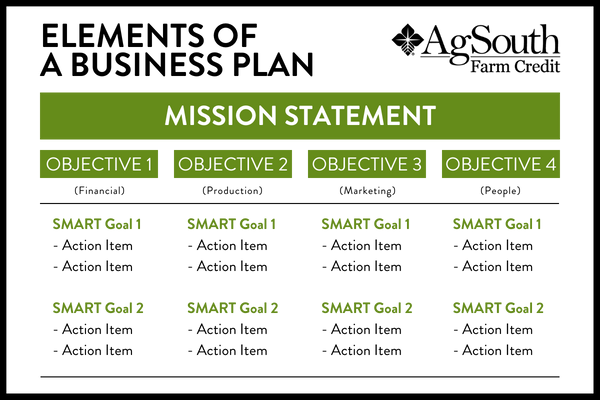Do You Want to Write a Business Plan? Do These 4 Things First.

Do You Want to Write a Business Plan? Do These 4 Things First.
If you’re looking to obtain financing for your farming operation, no matter how big or small, you’ll need a business plan. A business plan is a document laying out the feasibility of a new business and will help show your lender how serious you are. It provides a roadmap for the first several years of operation.
Writing a business plan from scratch can be overwhelming. This article goes over what you will need to do before you start writing your business plan that will make the writing process go much more smoothly.
In this article, we go over how to:
- Develop a Mission Statement
- Define Your Objectives
- Set SMART Goals
- Develop Action Plans for Your Goals
Refer back to the below graphic as you begin to put thought in to each section.

Develop a Mission Statement
Your mission statement is important and should be the first thing you address when starting a business or taking over a business. It’s the “why” behind everything you do. Those who put genuine thought behind their mission statement will have a solid resource to return to when difficult business decisions arise later down the road. Your mission statement keeps you accountable and keeps you true to who you are. Don’t take this step lightly.
Although incredibly important to your business, you don’t need to overthink its development.
Your mission statement doesn’t have to be long or thought provoking. It can be a simple sentence or two. To develop your statement, ask yourself “What do I want to do and why?”.
An example of a strong mission statement for a local you-pick operation Big Ben’s Blueberries could be:
Grow good food. Make good money. Be good people.
Define Your Objectives
Objectives within your business plan should focus around four areas:
- Financial
- Production
- Marketing
- People
Think of objectives as directions that guide what the business will look like and how it will function. Depending on the size of your operation, you can have multiple objectives per focus area. An example of a marketing objective would be to increase brand awareness and a financial objective example would be achieving a net profit of $45 million.
As your business evolves these objectives will change. This is where your mission statement will be helpful. Staying focused on what you want to do and why will help you define your objectives.
Set SMART Goals
Once your objectives are set. You’ll want to establish goals for how to reach each objective. Without a clear plan on how to achieve your objectives, your business might not grow at the pace you need it to for profitability.
We recommend using the common acronym SMART when setting your goals.
S – Specific
M – Measurable
A – Attainable
R – Realistic
T – Timely
As you come up with your goals, make sure each one is specific, measurable, attainable, realistic and timely to your current state of business is key. What does that look like? For example, “Increase yields” is not a SMART goal because it is not specific or measurable. A SMART version of that goal might be “Increase blueberry yields to an average of 800 pounds per acre.”
Develop Action Plans
Once your goals are set, you’ll need to develop action items that explain how you are going to accomplish those goals. Think “what, where, when, how and how often”. An example of an action plan for increasing brand awareness in your marketing objective could be making sure to sell your product at four farmers markets each month. Again, these are specific initiatives or line items needed to obtain your goal and ultimately your objective.
Put It All Together and Pitch Your Plan to Your Lender
Once you have put some thought into the above elements, you can begin building your business plan. Using an example farm business called Big Ben’s Blueberries, the beginning of your business plan could look something like this:

The elements we discussed above are fundamental to building a plan that has a solid direction and purpose. Your business plan will include these elements plus more. A good business plan includes:
- An overview on your business and future plans
- Current and projected financials
- Plans for additional financing and capital
- A list of trusted partners like accountants, attorneys, etc
- Plans for mitigating risk
During our award-winning AGAware finance workshops, we reference the AgPlan tool to help build your overall business plan for agricultural businesses. You can find an overview of this tool by watching this video. For more farm finance education, workshops, and resources visit our Farm Education page.